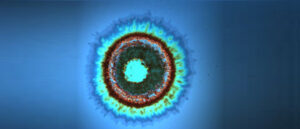Laser Damage Threshold
Laser damage threshold testing is a destructive test performed in general compliance with the ISO/DIS 11254 specification. In all cases, the lasers used in these measurements have a Gaussian profile in the focal plane. A number of lasers sources are available which span the ultraviolet to the far infrared.

When performing Laser Damage Threshold testing the sample is irradiated numerous times using a small beam over the whole clear aperture of the sample. In most cases, 10 sites are irradiated at each fluence of Irradiance level. The sample is observed using a Nomarski microscope at up to 500x to determine if the laser irradiation had physically altered the coating or substrate surface. The samples are mounted in a configuration, which allows them to be moved from the microscope focal plane to the laser beam using a series of high accuracy motorized translation stages. A sample is observed with the microscope, moved to the beam and irradiated. The sample is then returned to the microscope and inspected.
In a Laser Damage Frequency measurement, the irradiation is performed for 10 sites and the percentage of sites that exhibit damage is recorded. Based on the data the laser fluence is either increased or decreased and the procedure continued. At some point below the damage threshold, 0 of 10 sites will fail. At fluence levels well above the damage threshold, 10 of 10 sites will fail. Within these extrema, the percentage of sites which fail will be proportional to the incident fluence. A linear regression plot of the percentage of failed sites is generated and the point at which the line crosses the ordinate is considered the damage threshold. This is the level at which there is statistically 0 probability of damage. Typically numerous fluence levels will be irradiated below this damage threshold to further confirm the calculated value.
In some cases, where preferential damage sites may be less randomly distributed or on coatings manufactured with unusual materials, the damage may not follow this linear relationship. In that case, the data is reported as a Least Fluence Failure measurement. In this case, 10 sites are irradiated and observed. If no damage is present the fluence is increased and 10 additional sites are irradiated. This procedure is continued until damage is observed in at least one of the ten irradiated sites. The damage threshold is defined as the highest fluence or irradiance at which 0 of 10 sites fail.
The preceding paragraphs provide a brief overview of the laser damage test procedure. While these types of tests are the most common, individualized tests can also be designed for specific applications.
If you are interested in our laser damage threshold testing, please fill out our laser damage threshold test form.
Testing
Company
Forms
Media
Contact
Spica Technologies
18 Clinton Dr. #3
Hollis, New Hampshire 03049
Phone: (603) 882-8233
Fax: (603) 882-8614
